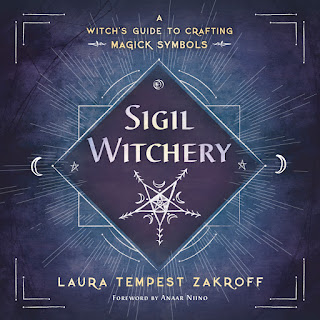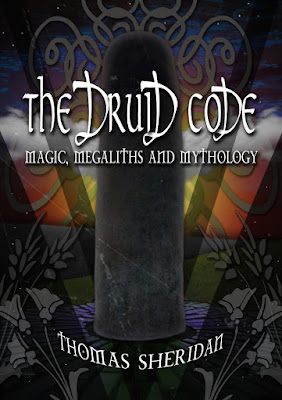Review: Sigil Witchery: A Witches Guide to Crafting Magick Symbols by Laura Tempest Zakroff.
Sigil Witchery
is both a thorough and often surprising history of sigils, as well as an
entertaining practical guide suitable for the beginner and advanced
practitioner alike.
Crucially, Zakroff
is respectful of the many world traditions and cultures she draws her
information from and also brings her own knowledge and application to the
subject.
The result
is a book which allows the reader to understand sigils from the many perspectives
of folklore and witchcraft and which guides the reader through exercises and
applications which can later be pursued in a personal direction.
Before the
review proper, a word of appreciation has to go out to the staff at Llewellyn
who designed the format of this book.
Because the
author used so many illustrations and exercise pages, the usual book dimensions
would have been inadequate in displaying how the writing and drawings
compliment each other.
The layout instead
allows the reader to easily take in the designs and photographs and compare the creative potential of sigil designs which often follow on from
each other in the later stages of the book.
Outside of
Austin Osman Spare, it is arguably Gordon white of Rune Soup who brought this
form of archaic magic to the forefront of the recent occult renaissance.
(“Whatever that is!” I hear some of my readers say.)
Zakroff’s
approach appreciates that sigil magic is a powerful tool because it incorporates
so many diverse aspects of how we interact with the world and those around us.
Whether it
is our physical senses or psychological profile, she demonstrates how
everything from art, to how we communicate, and indeed the roots of language
itself combine within our unconscious mind. All are aspects of ourselves which
we can bring to bear on how we personalize our sigils.
The popular
context of simply writing out a desire and activating the sigil will seem a lot
less ambitious having read this book.
Zakroff guides
the reader through a journey of symbolic and sympathetic magic, from cave
paintings depicting the hope for a successful hunt, to the more esoteric,
entopic symbols, often thought to be a result of entheogens and shamanic
ritual.
Zakroff
brings up important points such as identity and what defines ‘progress’; both
of these concepts having been often misconstrued in the past. As David Lewis Williams
noted in his groundbreaking work, The Mind in the Cave, previous academic and
anthropological theories often reduced the worth of indigenous wisdom
traditions and, indeed, our very ancestors.
Zakroff traces the evolution of signs and symbols, recognizing and explaining the
crucial differences between them before moving us onto more complex and,
perhaps, more directly intended, motifs, designs and images.
As well as
covering a vast time-scale, Zakroff includes a vast array of
cultural uses of sigils encompassing the entire globe. From Australia and New
Zealand to Morocco
As
mentioned, the book contains enough depth to be used by those already familiar
with sigils but who may not have explored the subject as widely as the author.
Examples of this include how Zakroff describes alternative forms which might include numbers, directions and elements.
Examples of this include how Zakroff describes alternative forms which might include numbers, directions and elements.
Personally
speaking, I had never even thought about which direction letters in my own
sigils had faced and found this to be a real revelation.
And, obviously, those with an interest in numerology will immediately see how the incorporation of magically relevant numbers can provide a potent and personal seal for themselves.
And, obviously, those with an interest in numerology will immediately see how the incorporation of magically relevant numbers can provide a potent and personal seal for themselves.
Later, the
author demonstrates how color and astrological symbols can be included once the
practitioner begins to develop their sigils even further.
However, Zakroff provides some good advice for those intending to use other magical systems within their sigils when she writes, “You should understand what a symbol means, where it comes from, and how and why it’s used.”
However, Zakroff provides some good advice for those intending to use other magical systems within their sigils when she writes, “You should understand what a symbol means, where it comes from, and how and why it’s used.”
The concept
of condensed magic is deceptive, and in the second half of the book Zakroff
gives her own theories about sigils and how and why they work. Utilizing her
obvious psychological expertise, as well as her own traditional and individual
witchcraft techniques, the reader is shown how potent condensed spell work
can actually be.
The author
demonstrates how the function of sigils can be applied to desire, warding,
personal development and deeper, ongoing ritual work.
In his
essay, Approaching the Unconscious, Carl Jung wrote, “Whatever the unconscious
may be, it is a natural phenomenon producing symbols that prove to be
meaningful.”
In Sigil
Witchery: A Witches Guide to Crafting Magick Symbols, Zakroff shows the reader
a path leading to our deeper selves and the means by which we can begin to work
with these symbols and utilize the language of our unconscious minds.
David
Halpin. (c)
Purchase Sigil Witchery: A Guide to Crafting Magick Symbols from the publisher here.
Laura Tempest Zakroff Facebook Page here.




.png)


Comments
Post a Comment